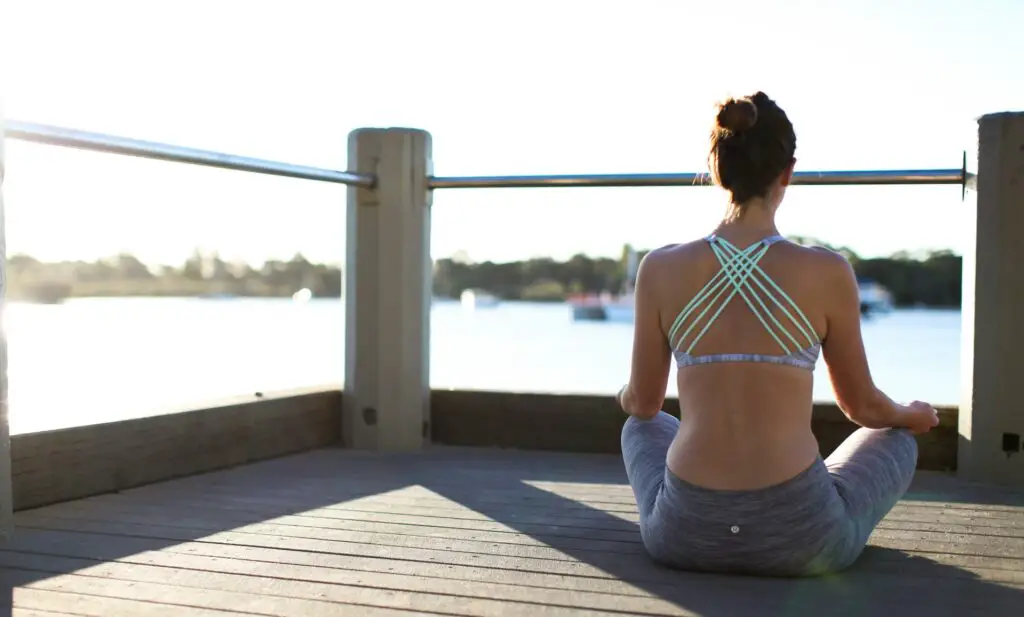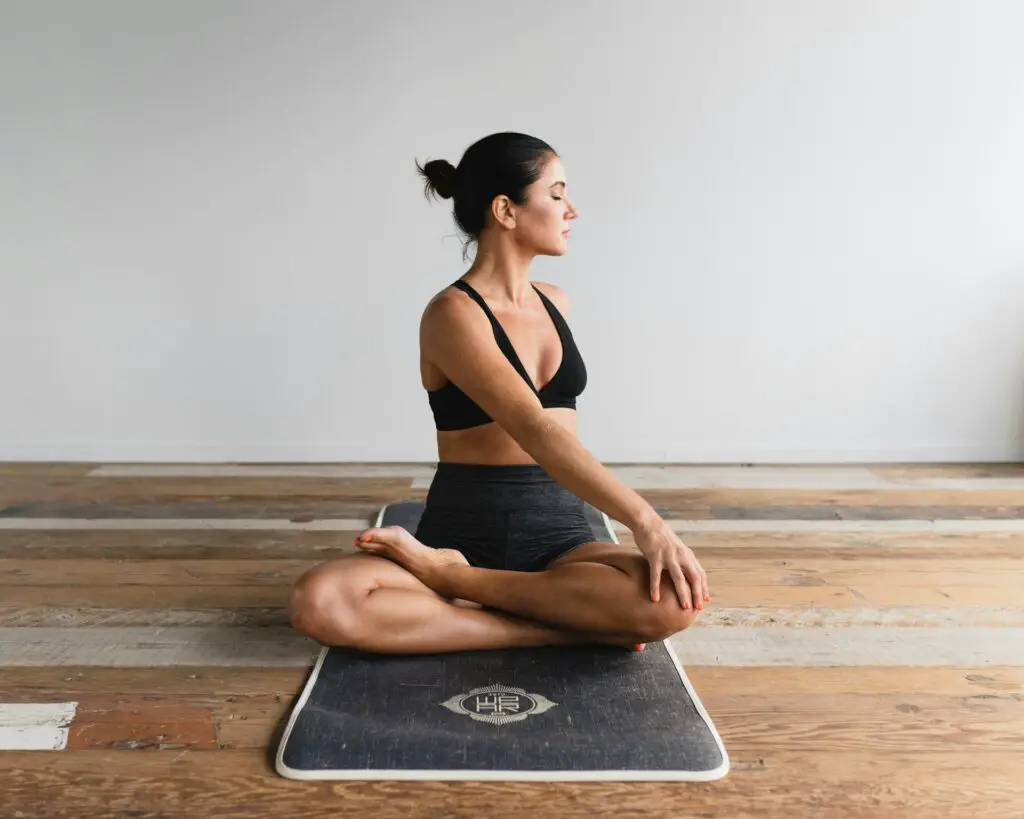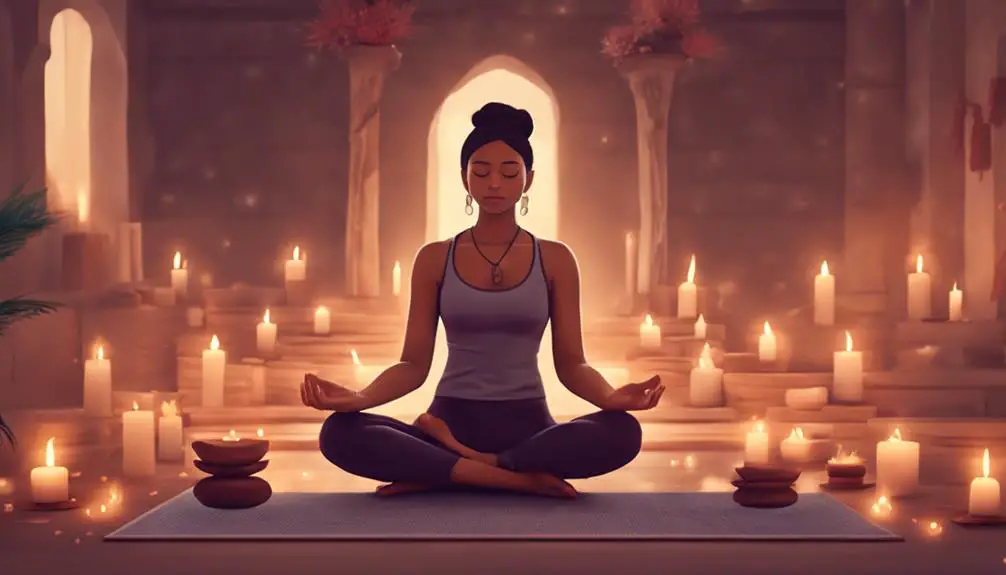As you start your journey into yoga meditation, it’s important to grasp the fundamental steps for a richer experience.
Understanding the advantages of mindfulness, breathwork, and basic poses is key to developing a practice that can benefit your overall well-being.
Begin by setting up a calm space, practicing gentle movements, and focusing on your breath.
These initial actions lay a strong groundwork for your meditation routine, leading you toward self-discovery and inner peace.
Benefits of Yoga Meditation
Starting yoga meditation brings a host of benefits for your mind, body, and spirit. One big plus is how it helps dial down stress and boost relaxation.
By focusing on deep breathing and mindfulness, you can calm your mind and release tension from your body, creating a peaceful feeling.
Yoga meditation can sharpen your mental focus and clarity. By quieting the mental noise, you can enhance your attention and productivity in daily tasks.
This mental clarity can also help you tune into your thoughts and feelings better, giving you more self-awareness.
Adding yoga meditation to your routine can also perk up your physical health.
It can lower blood pressure, beef up your immune system, and improve flexibility and balance.
By nurturing your mind, body, and spirit through yoga meditation, you can foster a greater sense of balance and overall well-being in your life.
Setting Up Your Meditation Space
When setting up your meditation space, arrange it thoughtfully for a calming atmosphere. Decor elements can enhance the ambiance and connect you to your practice.

Lighting is key for the right mood during meditation sessions.
Space Organization Tips
Create a dedicated meditation area in your home to enhance your focus and relaxation.
Find a quiet spot with minimal distractions. Keep the area tidy and organized to promote a sense of peace.
Consider adding a comfortable cushion or mat for seating during meditation.
Natural light can be calming, so position your space near a window if possible. Adding a plant or soothing artwork can improve the ambiance.
Essential Decor Elements
Enhance your meditation space with these practical decor tips to elevate your practice:
- Comfortable Seating: Opt for a cushion or chair that supports good posture for extended sitting sessions.
- Natural Elements: Bring in plants, stones, or wooden accents to add a calming touch of nature to your meditation area.
- Personal Touches: Personalize your space with photos, candles, or meaningful symbols that resonate with you.
Lighting Considerations
Focus on the lighting to enhance your practice. Soft, gentle lighting creates a peaceful atmosphere for better meditation.
Try using candles, Himalayan salt lamps, or string lights for a warm glow.
These lights can help you relax, concentrate, and center your mind. Avoid bright overhead lights that can be distracting. Instead, go for softer, indirect lights that promote calmness.
Experiment with different lighting setups to see what works best for you and improves your meditation routine.
Basic Yoga Poses for Meditation
If you’re new to yoga meditation, starting with basic poses is key for a peaceful practice.
Here are three foundational poses to kickstart your journey:
- Child’s Pose: This gentle pose helps relax your back and release tension, setting a calming tone for your practice.
- Easy Pose (Sukhasana): Sitting cross-legged in this pose grounds you and promotes a centered feeling, perfect for meditation and clearing your mind.
- Corpse Pose (Savasana): This final relaxation pose lets you fully unwind, relax, and absorb the benefits of your practice.
Focus on your breath as you move through these poses, staying present in the moment.
They’ll bring comfort and stability, setting the stage for a deeper connection between your body, mind, and spirit during meditation.
Breathing Techniques for Beginners
To start with mastering basic breathing exercises. These techniques help you sync your mind and body, fostering inner peace and relaxation.
Accept the advantages of taking deep breaths to ease stress and bring serenity into your practice.
Let’s explore the principles of breathing for a calmer, more connected experience.
Basic Breathing Exercises
Start with these basic breathing exercises to kickstart your meditation journey.
Give these simple techniques a go-to to center your mind and body:
- Deep Breathing: Breathe in slowly through your nose, feel your belly expand, then exhale through your mouth, letting it deflate.
- Equal Breathing: Inhale for four counts, exhale for the same count, maintaining a steady rhythm.
- Alternate Nostril Breathing: Block one nostril with your thumb, breathe in through the other, then switch and exhale through the opposite nostril. Repeat this pattern.
These exercises help you find peace and focus as you delve into meditation.
Benefits of Deep Breaths
Starting your meditation journey with deep breathing techniques can have numerous benefits for beginners.

Deep breaths can help calm your mind and reduce stress, setting the stage for a more relaxed meditation experience.
By focusing on your breath, you can boost mindfulness, improving your ability to stay present and attentive.
Deep breathing also enhances oxygen flow in your body, which can boost your overall well-being.
This practice can help steady your heart rate and lower blood pressure, fostering feelings of tranquility and inner peace.
Take a moment to breathe deeply and feel the positive effects spread through your body.
Guided Meditation for Relaxation
Prepare for relaxation with this guided meditation. Close your eyes, take a deep breath in, and exhale slowly to release tension.
Focus on your breath – feel the air entering and leaving your body.
Start at your toes and scan your body, releasing any tightness or discomfort as you move up.
Picture yourself in a calm place – a beach, a forest, or a cozy room – and let that peaceful image wash over you.
Overcoming Common Meditation Challenges
When meditating, it’s normal to get distracted. Don’t stress about it.
Just notice when your mind wanders and gently bring your focus back to your breath.
Distractions are part of the process for everyone. Instead of feeling frustrated, see them as chances to practice staying present.
The goal isn’t to block out distractions completely but to handle them skillfully.
Feeling restless during meditation?
Try some gentle movements like stretching or walking. Find a comfy position that works for you.
Listen to your body’s cues and be patient as you explore different techniques. By being kind to yourself and experimenting, you can improve your meditation practice.
Incorporating Meditation Into Daily Routine
If you want to make meditation a part of your daily routine, here are some practical tips to help you get started and stick with it:
- Start Small: Begin with just a few minutes of meditation each day. Gradually increase the time as you get more comfortable.
- Pick a Time: Choose a specific time of day to meditate. Whether it’s in the morning to kickstart your day or in the evening to unwind, consistency is key.
- Find a Quiet Spot: Create a peaceful area where you won’t be disturbed. This dedicated space can help you focus and relax during your practice.
Incorporating these simple steps can help you weave meditation effortlessly into your daily life, promoting inner peace and mindfulness along the way.
Conclusion
Remember that every breath you take during your yoga meditation will bring you one step closer to inner serenity and well-being.
Allow your thoughts to wander and your body to relax, just like a serene stream meandering through a verdant forest.
Accept the silence inside of you and maintain your attention on the here and now.
You can find peace and harmony in your daily life with consistent effort and dedication.
FAQs
Can Yoga Meditation Help With Weight Loss?
Certainly! Yoga meditation can help with weight loss by increasing your awareness of your body and mind.
When you practice yoga meditation, you learn to pay attention to your thoughts and feelings, which can lead to making healthier choices. By reducing stress and promoting mindfulness, yoga meditation supports you in developing positive habits.
Is It Necessary to Chant During Meditation?
In meditation, chanting is optional. While some find it helps them focus, the main aim is to discover inner peace and calmness. Try different methods to see what suits you best.
How Long Should a Meditation Session Last?
When meditating, aim for sessions that fit your comfort and schedule. Start with 10-15 minutes each day and gradually increase as you feel ready. Consistency is key, so find a routine that works well for you.
Can Meditation Cure Mental Health Disorders?
Meditation can be a helpful addition to traditional mental health treatments, but it’s not a magic fix for disorders. Regular practice might assist in symptom management and boost your overall well-being.
Should I Eat Before or After a Meditation Session?
Before or after meditating, having a light snack can help. But remember, a big meal can make you feel sluggish and disrupt your focus. Find the middle ground for better results.




